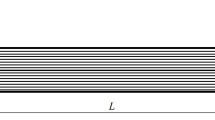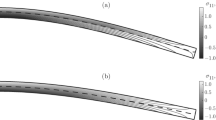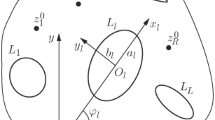In a geometrically linear formulation based on the use of variational principles of elasticity theory and the generalized Galerkin method, three approaches to constructing equations of static bending of orthotropic plates with a constant thickness are considered. The displacements of plate points are approximated by polynomials in the transverse coordinate with unknown coefficients of expansion. The application of variational principles leads to the first two approaches for constructing these equations. In the first approach, the force boundary conditions on faces of the plates are not taken into account, but the resulting two-dimensional equations and the corresponding boundary conditions on their edges are consistent, since, according to these equations, any subarea of the plates and the entire structures as a whole are in equilibrium. The two-dimensional equations of statics and boundary conditions on edges of the plates obtained within this approach can also be obtained by the generalized Galerkin method. The simplest theory using this approach is the Reissner theory. The second approach takes into account the force boundary conditions on faces of the plates. The latter circumstance leads to the necessity for using dependent variations of kinematic variables or introduction of undetermined Lagrange multipliers. It is shown that the resulting two-dimensional static equations and boundary conditions on plate edges are inconsistent, since any arbitrary subarea of the plate and the entire structure as a whole are in the nonequilibrium state. The two-dimensional statics equations and boundary conditions constructed in this approach cannot be obtained by the generalized Galerkin method. The simplest theories using this approach are the Reddy–Nemirovskii and the Margueere–Timoshenko–Naghdi theories. The third approach takes into account the force boundary conditions on faces of the plates, but the two-dimensional equations and the corresponding boundary conditions on the edges are obtained by the generalized Galerkin method. The homogeneous polynomials in the transverse coordinate are used as weight functions. The two-dimensional equations and boundary conditions obtained in this approach are consistent. The simplest theory that uses this approach is the Ambartsumyan theory. The relevance of the study is determined by the fact that the choice of a simple, but adequate, theory of bending can be of fundamental importance in solving optimization problems for composite plates.

Similar content being viewed by others
References
A. L. Goldenveizer, Theory of Elastic Thin Shells [in Russian], M., Nauka (1976).
L. Aghalovyan, Asymptotic Theory of Anisotropic Plates and Shells, London; Singapore: World Scientific Publishing (2015).
V. V. Kiselev and D. V. Dolgikh, Nonlinear Elastic Patterns of Dents on the Surfaces of Loaded Plates and Shells [in Russian], M., Fizmatlit (2012).
I. Andrianov and Ya. Avreitsevich, Methods of Asymptotic Analysis and Synthesis in the Nonlinear Dynamics and Mechanics of Deformable Solids [in Russian], М.; Izhevsk, Inst. Kompyut. Issl. (2013).
V. Z. Vlasov and N. N. Leontyev, Beams, Plates and Shells on an Elastic Foundation [in Russian], M., Fizmatgiz (1960).
A. N. Volkov, “Theory of thin shells on the basis of the method of initial functions,” Prikl. Mekh., 7, No. 10, 42-47 (1971).
V. V. Vlasov, Method of Initial Functions in Problems of Elasticity Theory and Structural Mechanics [in Russian], M., Stroiizdat (1975).
G. L. Gorynin and Yu. V. Nemirovskii, 3D Problems of Bending and Torsion of Layered Structures. Method of Asymptotic Splittings [in Russian], Novosibirsk, Nauka (2004).
N. A. Kil’chevskii, The Basics of Analytical Mechanics of Shells [in Russian], Kiev, Izd. AN SSSR (1963).
I. N. Vekua, Some General Methods of Constructing Various Variants of Shell Theory [in Russian], M., Nauka (1982).
S. G. Lekhnitskii, Anisotropic Plates [in Russian], М., L., OGIZ (1947).
J. M. Whitney and A. W. Leissa, “Analysis of heterogeneous anisotropic plates,” J. Appl. Mech., 36, No. 2, 261-266 (1969).
L. H. Donnell, Beams, Plates and Shells, N.Y., McGraw-Hill (1976).
V. L. Biderman, Mechanics of Thin-Walled Structures. Statics [in Russian], M., Mashinostroenie (1977).
E. Reissner, “On the theory of bending of elastic plates,” J. Math. Phys., 23, No. 4, 184-191 (1944).
R. D. Mindlin, “Thickness-shear and flexural vibrations of crystal plates,” J. Appl. Phys., 23, No. 3, 316-323 (1951).
E. Reissner, “A consistent treatment of transverse shear strain in laminated anisotropic plates,” AIAA J., 10, No. 5, 716-718 (1972).
K. Washidzu, Variational Methods in Elasticity and Plasticity, Oxford; N. Y.; Toronto; Sydney; Paris; Frankfurt, Pergamon Press (1982).
V. V. Vasiliev and E. Morozov, Advanced Mechanics of Composite Materials and Structural Elements, Amsterdam, Elsevier (2013).
L. I. Shkutin, Nonlinear Deformations and Disasters of Thin Bodies [in Russian], Novosibirsk, Izd. SO RAN (2014).
V. O. Kaledin, S. M. Aul’chenko, A. B. Mitkevich, E. V. Reshetnikova, E. A. Sedova, and Yu. V. Shpakova, Modeling the Statics and Dynamics of Shell Structures from Composite Materials [in Russian], M., Fizmatlit (2014).
S. A. Ambartsumyan, Theory of Anisotropic Plates. Strength, Stability and Vibrations [in Russian], M., Nauka (1987).
A. K. Malmeister, V. P. Tamuzh, and G. A. Teters, Strength of Polymer and Composite Materials [in Russian], Riga, Zinatne (1980).
J. N. Reddy, “A refined nonlinear theory of plates with transverse shear deformation,” Int. J. Solids and Structures, 20, No. 9, 881-896 (1984).
J. N. Reddy, “A simple higher-order theory for laminated composite plates,” J. Appl. Mech., 51, No. 4, 745-752 (1984).
J. N. Reddy, Energy and Variational Methods in Applied Mechanics, N.Y., John Wiley (1984).
Yu. V. Nemirovskii and B. S. Reznikov, Strength of Structural Elements from Composite Materials [in Russian], Novosibirsk, Nauka (1986).
A. Andreev, Elasticity and Thermoelasticity of layered Composite Shells. Mathematical Model and Some Aspects of the Numerical Analysis, Saarbrucken (Deutschland), Palmarium Acad. Publ. (2013).
C. H. Thai, “Analysis of laminated composite plates using higher-order shear deformation plate theory and mode-based smoother discrete shear gap method,” Appl. Math. Modeling, 36, No. 11, 5657-5677 (2012).
S. Mau, “A refined laminated plates theory,” J. Appl. Mech., 40, No. 2, 606-607 (1973).
R. Christensen, K. Lo, and E. Wu, “A high-order theory of plate deformation. Part 1: homogeneous plates,” J. Appl. Mech., 44, No. 7, 663-668 (1977).
N. A. Abrosimov and V. G. Bazhenov, Nonlinear Problems of Dynamics of Composite Structures [in Russian], N.Novgorod, Izd. NNGU (2002).
V. A. Bazhenov, O. P. Krivenko, and N. A. Solovei, Nonlinear Deformation and Stability of Elastic Shells of Nonuniform Structure: Models, Methods, Algorithms, Poorly Studied and New Problems [in Russian], M., Knizhn. Dom “LIBROKOM” (2012).
K. Belkaid, A. Tati, and R. Baumaraf, “A simple finite element with five degrees of freedom based on Reddy’s thirdorder shear deformation theory,” Mech. Compos. Mater., 52, No. 2, 257-270 (2016).
S. K. Golushko and Yu. V. Nemirovskii, Direct and Inverse Problems of the Mechanics of Elastic Composite Plates and Shells of Revolution [in Russian], M., Fizmatlit (2008).
S. A. Ambartsumyan, General Theory of Anisotropic Shells [in Russian], M., Nauka (1974).
A. N. Andreev and Yu. V. Nemirovskii, Multilayer Anisotropic Shells and Plates. Bending, Stability and Vibrations [in Russian], Novosibirsk, Nauka (2001).
E. I. Mikhailovskii, Mathematical Models of the Mechanics of Elastic Bodies [in Russian], Syktyvkar, Izd. Syktyvkar Univ. (2007).
I. G. Zhigun, M. I. Dushin, V. A. Polyakov, and V. A. Yakushin, “Composites reinforced with a system of three straight direct mutually orthogonal fibers. 2. Experimental study,” Polymer Mechanics, No. 6, 895-900 (1973).
Yu. V. Nemirovskii and A. P. Yankovskii, “On the applicability limits of some calculation theories of bent reinforced plates,” Nauch. Vest. NGTU, 18, No. 3, 91-113 (2004).
A. P. Yankovskii, “Elastoplastic deformation of flexible reinforced plates with a reduced shear strength,” J. Appl. Math. Mech., 77, No. 6, 613-628 (2013).
A. P. Yankovskii, “Applying the explicit time central difference method for numerical simulation of the dynamic behavior of elastoplastic flexible reinforced plates,” J. Appl. Mech. Techn. Phys., 58, No. 7, 1223-1241 (2017).
A. P. Yankovskii, “Constructing a refined model of elastoplastic behavior of flexible reinforced plates at dynamic loading,” Mekh. Kompoz. Mater. Konstr., 23, No. 2, 283-304 (2017).
A. P. Yankovskii, “Equal-stressed reinforcement of metal-composite plates in transverse bending at steady-state creep with account of weakened resistance to in-plane shears,” Mech. Compos. Mater., 52, No. 1, 1-16 (2016).
A. P. Yankovskii, “Deflections of uniformly stressed reinforced plates with account for their weakened resistance to the transverse shear,” J. Appl. Mech. Techn. Phys., 58, No. 1, 173-181 (2017).
W. Nowacki, Teoria Sprężystości, Warszawa, PAN (1970).
Yu. Tarnopolskii and I. Zhigun, 3D-Reinforced Composite Materials. Handbook [in Russian], M., Mashinostroenie (1987).
Author information
Authors and Affiliations
Corresponding author
Additional information
Translated from Mekhanika Kompozitnykh Materialov, Vol. 56, No. 3, pp. 407-436, May-June, 2020.
Rights and permissions
About this article
Cite this article
Yankovskii, A.P. Critical Analysis of the Equations of Statics in the Bending Theories of Composite Plates Obtained on the Basis of Variational Principles of Elasticity Theory 1. General Theories of High Order. Mech Compos Mater 56, 271–290 (2020). https://doi.org/10.1007/s11029-020-09880-8
Received:
Revised:
Published:
Issue Date:
DOI: https://doi.org/10.1007/s11029-020-09880-8




